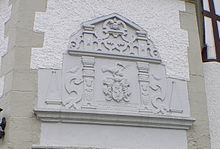Lispenhausen moated castle
| Lispenhausen moated castle | ||
|---|---|---|
| Creation time : | 13th Century | |
| Castle type : | Niederungsburg | |
| Conservation status: | Residential building | |
| Standing position : | Noble | |
| Place: | Rotenburg ad Fulda - Lispenhausen | |
| Geographical location | 50 ° 59 '29.8 " N , 9 ° 46' 5.2" E | |
|
|
||
The moated castle Lispenhausen is a well-preserved former moated castle built in the 16th century in Lispenhausen , a district of Rotenburg ad Fulda in the district of Hersfeld-Rotenburg in northern Hesse . The former moats , which took their water from the hazel , no longer exist.
Location and current state
The castle's house, which is still the most impressive building in the village, is located in the historic center near the church, on the site of a farm. On listed in east-west direction of the two-storey solid substructure of about 20 × 17 m Surface area to rest a truss floor in the style of the Renaissance and a roof storey , each having four gable dormer windows on each side of the saddle roof . The top floor is also made of half-timbered construction on the east gable side , while the opposite side is now shingled . The striking, hexagonal, about 5 m thick stair tower on the eastern gable side was added in 1605 by Adam von Trott; with its bell dome it towers over the roof of the manor house. Above the entrance to the stair tower is the coat of arms of the Bartheld family, who owned the building from 1640 to 1848, including the motto "In Deo mea consolatio, benedictum nomen Domini" (God is my consolation, praise be the name of the Lord) .
The castle included the large manor , which the von Trotts owned half as early as 1252 and as a landgrave-Hessian fief from 1485 .
history
The moated castle was built by the von Trott gentlemen, who were already wealthy in Solz , Imshausen and Schwarzenhasel . It was probably a replacement for the old Lispenhausen Castle , which was subsequently abandoned and fell into disrepair. The first known fief holders of the large Freihof in Lispenhausen were Hermann von Trott, who was known as such in 1252 and who founded the Lispenhausen line of the Lords of Trott, and his brother Berthold. In 1261 Hermann was also Burgmann on the Boyneburg . Until 1616, the Trott estates in Hesse, and thus Lispenhausen, were mostly owned by all lines of the family, but in 1616 Werner von Trott received Imshausen, Gunkelrode and Lispenhausen, while his two younger brothers stayed in Solz. Werner von Trott resided in Imshausen and was the founder of the Imshausen line. In 1634 he sold Gunkelrode for half of Lispenhausen and in 1640 he exchanged Lispenhausen for the Iba suburb to Peter Bartheld (1609–1679), Hessian-Kasselscher colonel and later commander of the landgrave's palace in Marburg , which was owned by Landgrave Amalie Elisabeth of Hesse-Kassel in 1641 formally with the freehold was invested Lispenhausen. His son Anton (1660–1732) was born on November 28, 1701 by Emperor Leopold I , his son Johann Christian (1647–1714) on December 12, 1712 by Emperor Karl VI. ennobled , who was enfeoffed in 1641 by Landgravine Amalie Elisabeth von Hessen-Kassel with the Lispenhausen estate. The von Bartheld family owned the castle and the Lispenhausen manor for more than 200 years until it was sold in 1846 due to over-indebtedness. The Hildebrandt family followed suit, followed by August Lucius .
literature
- Rudolf Knappe: Medieval castles in Hessen. 800 castles, castle ruins and fortifications. 2nd Edition. Wartberg-Verlag, Gudensberg-Gleichen 1995, ISBN 3-86134-228-6 , (p. 171).
Web links
- http://schloesser.gnm.de/wiki/Lispenhausen_Rotenburg,_ehem._Wasserburg
- http://lispenhausen.de/historisches/GeschichtevonBartheld.pdf
- Photos of the moated castle Lispenhausen
- Photos of the moated castle Lispenhausen
Notes and individual references
- ^ R. Eichhorn: 1200 years of Lispenhausen . Ed .: Municipality of Lispenhausen. Rotenburg an der Fulda 1986, p. 55 .
- ↑ http://www.lispenhausen.de/historisches/knothe_chronik/chronik_knothe.pdf
- ↑ http://www.lispenhausen.de/historisches/knothe_chronik/chronik_knothe.pdf
- ↑ http://www.lispenhausen.de/historisches/knothe_chronik/chronik_knothe.pdf



